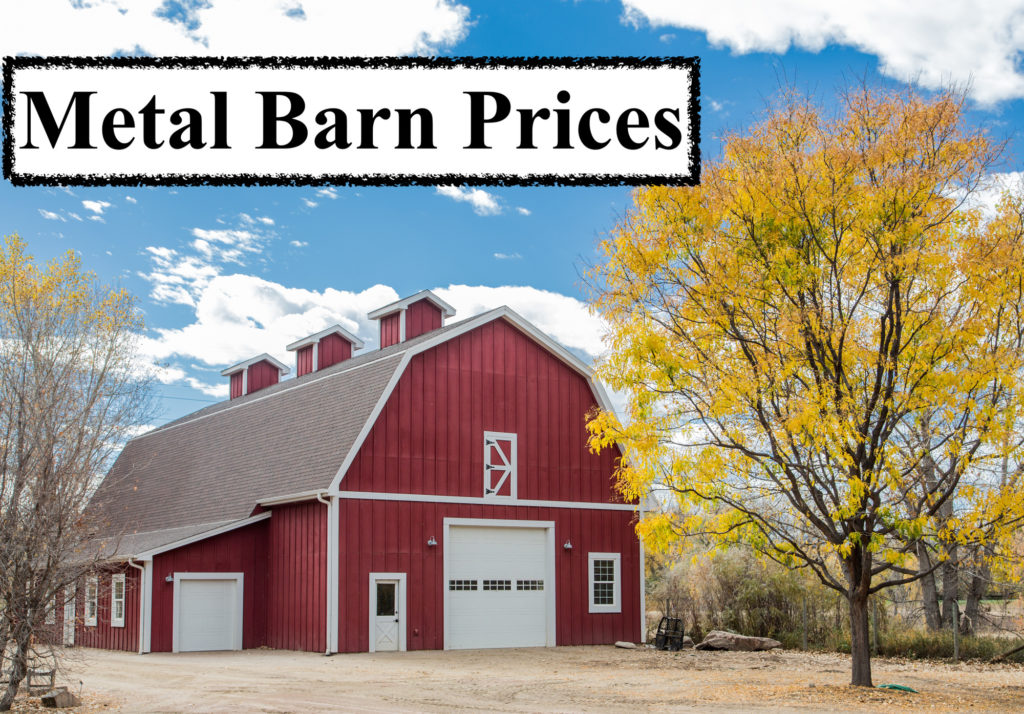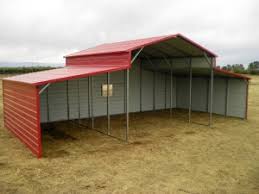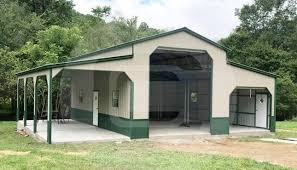Are you looking to purchase a metal barn? Here’s your guide to calculate the price of buying metal barns.
The image of a faded red wooden barn at some stage of disrepair is a fixture in Americana. If you’re charged with replacing that rotting barn, you might not be so nostalgic each time you see it.

You might look at it and wonder what you can do to improve on its longevity as well as its functionality. The answer in both cases is to consider building a metal barn in its place.
Let’s take a look at what today’s barn can be and why metal makes sense. Then let’s see how metal barn prices stack up so you can decide if this is something you should consider.

Why Build With Metal?
The advantages of building with steel over wood are clear:
- Steel won’t rot; wood will
- Steel is termite and mold resistant
- A metal building is less likely to be hit by lightning (if grounded)
- Steel can be recycled and reused over and over
- You can have a span of 200′ without needing a load-bearing column
All of these advantages can lead to fewer maintenance costs. For example, steel-framed buildings with metal roofs often have roof warranties of 40-50 years. Regular asphalt roofs typically last 15 years.

Ballpark initial costs for building a 40 x 60 building with metal over wood metal are $9 per square foot. This compares to $15 per square foot for a traditional pole barn.
To truly understand what will drive the price of your project you need to look into these costs a little deeper. There are three things that impact costs.
First are the design decisions that anyone looking to build will encounter. Next, there are the building code costs. Finally, there are the variable costs that are completely out of your control. Let’s look at these in reverse to see how they add up.
Variable Costs
Underlying the price of any project are the costs of the materials you use. In the case of metal barns, we’re talking first about the cost of steel.
Market values for steel obviously fluctuate with demand. You will see the price of steel drop when your building gets over 5,000 square feet and drop again when it gets over 10,000 square feet, but the current market value underlies it all.

To put that into perspective, the Producer Price Index for steel sat at 100.00 in December of 2010. It was 102.6 in December 2018 but had dipped as low as 88.6 in October 2016.
Fuel costs are another variable out of your control. Obviously, the cost to ship that steel to your location is going to be significant. High fuel prices at the time of your building will be passed along to you.
The purchasing power of your builder (if you are working with one) will also impact your materials costs. Larger companies can sometimes offer a lower price because they buy their steel in large quantities and get a discount.
Finally, you should include labor costs as a variable you can’t control. Like the cost of steel, labor prices fluctuate with market demand. However, the labor cost may not be too different for building a metal barn than a wooden one.
Building Code Costs
The second set of costs you need to determine are imposed by local, state or regional governments. Building codes vary by region and usually are set to meet specific safety requirements.
In coastal regions, there are building codes that require structures to be able to withstand higher wind speeds. A wind speed load of 175-mph is standard along the coasts where a wind load of 100-mph may be all that’s required inland.
In the north, you will encounter snow load building codes. Codes stating your building must be able to sustain a snow-load weight of 100+ pounds per square foot are common.
Seismic loads are usually set a little differently. Here different categories and levels of requirements are set according to the amount of soil movement that can be anticipated.
In other words, the type of soil surrounding your structure helps to determine how well your structure can withstand an earthquake. That, in turn, leads to requirements in your building’s design and construction to mitigate the overall risk.
For example, a Category A, level one building is one that is built where ground shaking is expected to be minimal, while a category A, level three building is in an area that can expect moderate shaking.

Design Costs
Here are the costs you may be expecting. Here there are basic structural design decisions you can make that will determine your final price as well as functional or aesthetic design decisions.
Two major design decisions will have a big impact on your final cost. They are the width of your building and the shape of your roof.
Open space is usually a major design requirement in a barn structure. You need wide open areas to house your equipment, livestock or to store your produce.
You can literally build any length metal barn you want. You are limited only by your land and overall budget. However, you can only push the width of your building out to 200 feet (some say 300 at an extreme) before you need to include a load-bearing wall or column.
The shape of your roof is also an important structural design decision. The arched roof of a Quonset hut can be up to 60% less expensive than either a straight-wall single slope roof or a gabled roof.
Other design costs are determined as much by in the internal form and functions required in your metal barn. These have evolved more than any other variable over the past decade.
In 2016, the HGTV show “Fixer Upper” introduced us all to the “barndominium.” On their home renovation show, Chip and Joanna Gaines took an old barn and turned it into a large and inviting family home.
Since then, many more “shomes” have been built. These metal pole barn houses combine both shop and living spaces and are as apt to be built in a suburban area as a rural one.
Additional Metal Barn Prices
The final cost variable is complexity. A shome is easily more complex than an open, large equipment storage shed. Storefront doors, roll up doors, steel frame openings all come with different price tags as do electrical and plumbing costs.
Now that you have thought through the basic design of your project, it’s time to start comparing metal barn prices. The easiest way to do that is to visit online sites like Portable Buildings and request a free quote.


